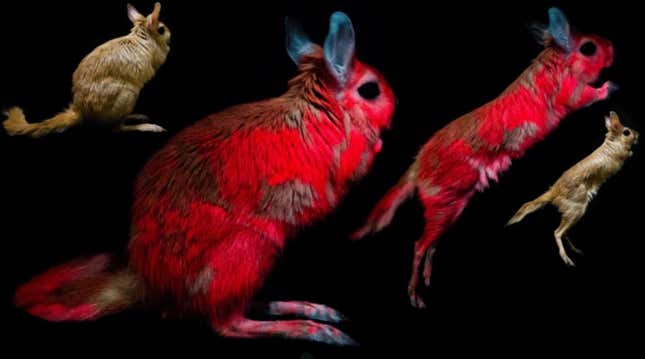
Springhares are cute as can be, but their fur looks kind of dull under normal conditions. When cast under UV light, however, their fur comes alive, featuring vibrant patches of red, orange, and pink. As new research shows, these creatures are now one of only a handful of mammals known to emit a biofluorescent glow.
Biofluorescence, in which an organism absorbs ultraviolet light and re-casts it as a colorful glow, has been documented in fish, amphibians, reptiles, birds, and even microscopic tardigrades. This trick is rare among mammals, but it does happen, at least in marsupial opossums, flying squirrels, and, as the world recently learned, the platypus, because of course.
New research published today in Scientific Reports is the first to document biofluorescence in springhares. It’s also the first evidence of this phenomenon in an Old World (i.e. not from the Americas) placental mammal.
These kangaroo-resembling rodents live in southern Africa, where they feed on plants and the occasional bug. Springhares are nocturnal-crepuscular (active at night and during twilight) and super jittery, never straying too far from their ever-changing burrows. And as the new research shows, they also glow in the dark, for reasons that remain unclear.

Erik Olson, the first author of the study and an associate professor of natural resources at Northland College in Wisconsin, along with his colleagues, made the discovery while studying biofluorescence in flying squirrels at the Field Museum of Natural History in Chicago. The same investigation led the team, which includes Northland College biologist Paula Spaeth Anich, to discover biofluorescence in platypuses.
These scientists are making it their business to detect biofluorescence in mammals, and they’re having considerable success. Their latest discovery “further supports the hypothesis that biofluorescence may be ecologically important for nocturnal-crepuscular mammals,” and that this trait “may be more broadly distributed [among mammals] than previously thought,” wrote the authors in their study.
Investigations done in April 2018 and again in November 2019 hinted at the possibility, leading to a detailed study of 14 museum specimens gathered from four countries and six captive animals sourced from zoos. Two different species of springhares were analyzed: Pedetes surdaster and Pedetes capensis, the latter of which is commonly referred to as the South African springhare.
When cast under UV light, the fur of springhares erupted in hues of pink, orange, and red, but they shone in irregular clumps (which is odd for biofluorescent mammals), appearing primarily around their heads, legs, hindquarters, and tails. Peaks of biofluorescence at 500 and 650 nanometers were detected in sections of highly fluorescent fur, which the researchers described as “funky and vivid.”
These glorious glowing colors are made possible by a class of organic compounds known as porphyrins, which are located on the springhares’ hair fibers. Porphyrin-based biofluorescence has been seen before among some marine invertebrates and birds, as well as the New Guinea flatworm, according to the research.
Biofluorescence was seen equally in both males and females, which means this trait is probably not sex-specific. As to why springhares have evolved this way, the scientists aren’t entirely sure, but they have some ideas.
“Springhares are predominantly solitary and tend to forage in more open areas with sparse vegetation and, therefore, have greater exposure to predators due to the lack of cover or group vigilance,” wrote the study authors. “Thus, we hypothesize that the patchiness of biofluorescence in springhares could function as a camouflage of sorts, but this would depend on the UV sensitivity of their predators.”
The scientists are recommending that more research be done to fully understand the ecological significance of biofluorescence in springhares and to determine why it’s so patchy. That other mammals might be biofluorescent remains a distinct possibility. And thank goodness for that—we need more glowing mammals in our lives.